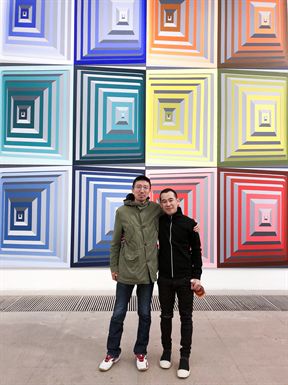Nov 04 - Nov 21, 2017
Press Release
Curator Article
Mirroring Edges: Li Kezheng Solo Exhibition
In 1958, Frank Stella was a fourth year student at Princeton University when he saw the works of Jasper Johns for the first time at the Leo Castelli gallery. Stella later explained about his experience, “What impacted me the most was Johns’ execution of motifs, lines, rhythmic space and his notions of repetition, I began to ponder upon the various complexities pertinent to these components of painting.”
In 2006, Tianjin Art Academy held an exhibition of Jorg Immendorf. Artist Li Kezheng was at the time receiving training on realist painting from the academy. The exhibition provided him an opportunity to debunk his preconceived ideology about art, with years of training and experiment, Li Kezheng began to paint works of abstraction with hard edge in a minimalist approach.
In 2010, Li Kezheng and Shang Yixin presented their exhibition, “The Edge of Time” at the Beijing XI Art Institute, where Li showed his minimal abstract paintings for the first time. It is apparent with these works to infer that Li Kezheng had eliminated appropriation and representational components of art forms from his practice, whose practice was equally resolute about rejecting expressionism, the everyday and the coincidental encounters that were once popular elements of artistic practice. By then, he had already become infatuated with monochromatic schemes, the subtle differences between the colors, with which he rendered images of variegated color blocks, with the geometric forms occupy the center of the image. This was also the periodthe Zen Master, Teitaro Daisetz Suzuki’s teaching had a great impact on Li Kezheng, with which the artist aimed to infuse the ultimate realm of Zen into the purity of spirituality.
In the book “Non-Objective World”, Kazimir Malevitch wrote, “The visual phenomenon of the objective world is essentially meaningless, only feelings in the contrary, have meaning as they are entirely isolated from the environment, by which to provoke emotions.” Li Kezheng’s most recent works further obscures the former geometric forms, in other words, they are transitions into an illusory space. Unlike the parallel and dispersive surfaces in Stella’s “Concentric squares”, Li adopts symmetry and interjecting lines, colorful gradations and contrasts, extending them either inwardly or outward from the concentric squares, allowing cursive lines to form beyond these edges in order to generate spaces of visual illusions – a physical visual space, as well as emotional and spiritual.














































